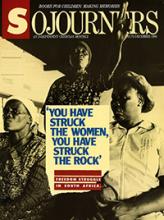EVERY DECEMBER, prior to holiday travel, our family has a festive, pre-Christmas meal in our home. We invite special guests—friends and neighbors who are short either on family (with whom to celebrate) or discretionary income (with which to throw a feast of their own)—to share a sumptuous meal. Afterward we gather in the living room to act out the Christmas story, assigning roles on the spot, with no rehearsals. It usually makes for some interesting casting choices—one year an 80-year-old woman played the role of Mary!
We break out our daughters' box of "costume clothes" for quick wardrobe selections. Someone also plays the role of narrator, reading the traditional Christmas narrative from the second chapter of Luke's gospel, providing rudimentary clues to keep our drama going. At appropriate points we interrupt the script to sing the first stanza of well-known carols. For the sake of added drama, we borrow a few lines from Matthew's Christmas story, so we can include the "wise men" episode (and sing "We Three Kings") in our storyline.
Ever wonder why Luke's account became the standard text from which the Christmas story is read? Why not Matthew, or Mark, or John? It could be because Luke has all the great lines: the shepherds "watching over their flock by night," the angels' comment about "good news of great joy," the image of a baby "wrapped in swaddling clothes," the heavenly host (picture the Mormon Tabernacle Choir) singing "Glory to God in the highest, and on earth peace among those with whom God is pleased."
Read the Full Article

